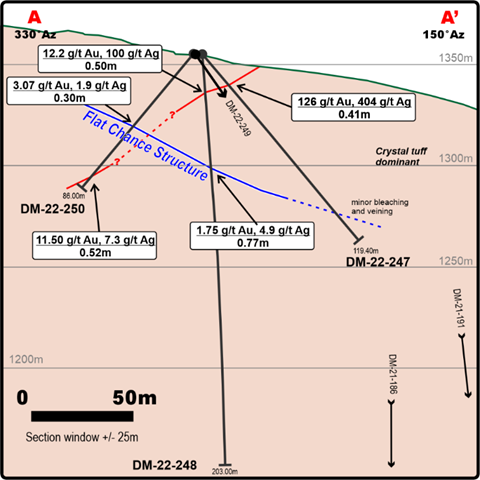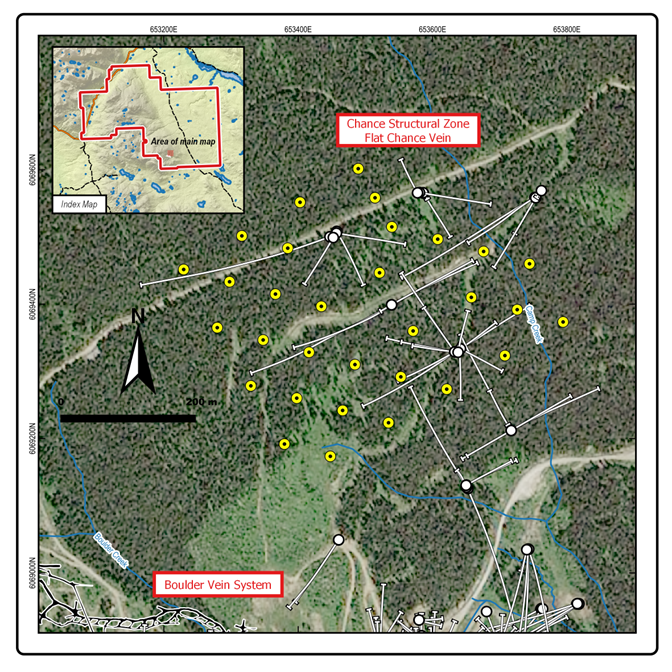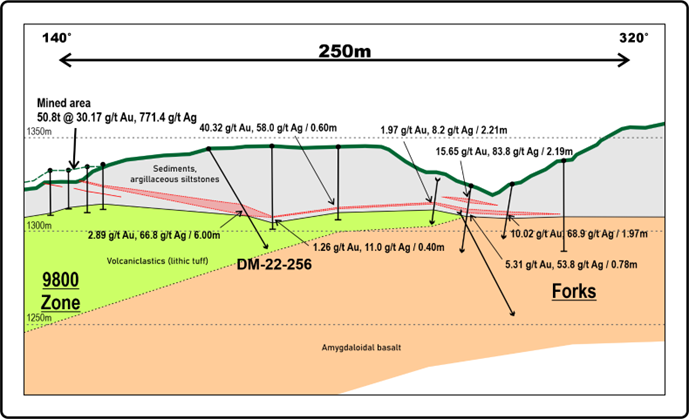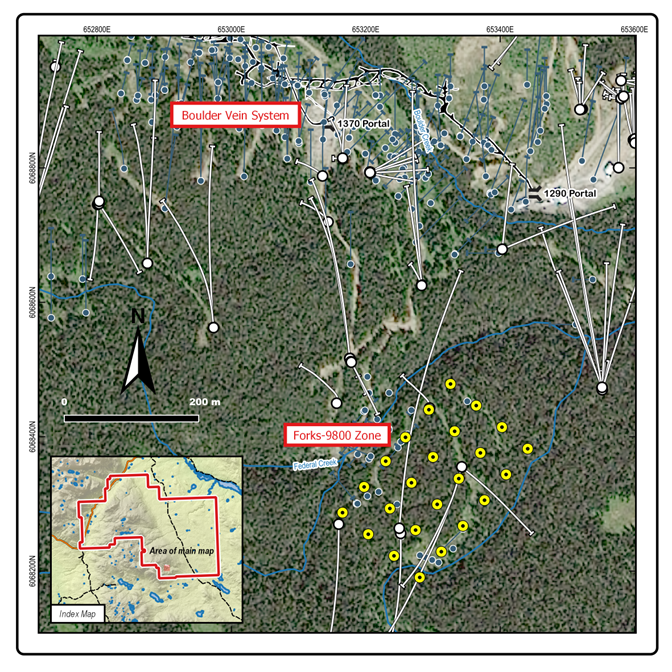Near-mine resource potential at Flat Chance and Forks-9800 Zone
High-grade vein targets at Alpine now ready for drilling
VANCOUVER, BC / ACCESSWIRE / May 24, 2023 / Blue Lagoon Resources Inc. (the "Company") (CSE:BLLG)(FSE:7BL)(OTCQB:BLAGF) is pleased to provide a thorough interpretation of exploration results from recent work conducted at its 100% owned Dome Mountain Project, a short 50-minute drive from Smithers, British Columbia and accessible year-round.
Potential of the Dome Mountain Project
Interpretation of recent exploration results from Dome Mountain by the company's geologic team suggests the following:
There is strong potential for defining 1M+ oz of gold along the Boulder Vein through systematic infill drilling.
The recently discovered Flat Chance vein system and historic Forks-9800 Zone provide possible opportunities for significant near-mine resource additions.
Historical assays from the Alpine area indicate good prospects for discovery of new high-grade veins.
Dome Mountain Project
The Dome Mountain Project covers an historical area of precious metal bearing veins centred on the past-producing Dome gold-silver mine which exploited the Boulder Main vein (1989-1992). The Project area is predominantly underlain by the Lower to Middle Jurassic Hazelton Group Island arc assemblage. The Telkwa Formation, at the base of the Hazelton Group, is the thickest and most extensive formation. The Nilkitkwa Formation conformably to unconformably overlies the Telkwa Formation and is an important host for mineral occurrences.
Almost 90,000 meters of drilling in 596 drill holes have been completed on the Property since 1985. Since 2020, the Company has completed 48,974 meters of drilling in 187 drill holes).

Boulder Vein System Resource
The Boulder Main Vein, as well as its subsidiary veins (Figure 2), are characterized by quartz with lesser carbonate and sulphide mineralization. Past deposit models considered the veins as mesothermal, but some characteristics of the deposit style suggest a quartz carbonate hosted base metal rich gold-silver vein system. Quartz-carbonate veins lacking sulphides are typically barren with respect to gold and silver. Quartz occurs both as white and massive or as clear and translucent and associated with higher gold grades. Carbonate minerals (ankerite, siderite and calcite) occur as cream to beige crystals. Small scale folds in the veins attest to continued movement after their formation. Sulphide minerals in the Boulder Vein constitute approximately 10% of the vein mineralogy but can range to over 50%. In decreasing order of abundance, the sulphide minerals are pyrite (6%), sphalerite (2.5%), chalcopyrite (1%), and galena-tetrahedrite-arsenopyrite (<1%). Pyrite occurs as fine euhedral cubic crystals disseminated throughout the wall rock alteration and in quartz veins as blebs, stringers and massive selvages. In the upper portion of the Boulder Main vein gold values correlate well with zinc and/or galena. Recent deep intercepts also show increasing copper content. The overall carbonate content can rage as high as 30% and underlies the unit as a natural pH buffer and non-acid generating (NAG) system.

To date the Company has drilled 94 drill holes (25,275 meters) into the Boulder Vein System since 2020. The current resource estimate includes drilling from the 2020 and 2021 Phase 1 infill campaigns (Table 1) as well as historical drilling.
Table 1: Summary of drilling by the Company on Boulder Vein System since 2020.
|
Year / Phase
|
No. Drill Holes
|
No. Meters
|
|
2020
|
26
|
3,786
|
|
2021 Phase 1
|
28
|
6,839
|
|
2021 Phase 2
|
1
|
509
|
|
2022 Phase 1
|
10
|
4,149
|
|
2022 Phase 2
|
19
|
7,083
|
|
2023 Phase 1
|
10
|
2,909
|
Through the initial programs of infill drilling the Company was able to increase the total gold ounces in the indicated category by 145%, or 102,582 ounces. In addition, 45,000 ounces of gold were moved into the measured category, which was a first for the project. The current mineral resource statement † (see News Release, February 3, 2022) discloses a mineral resource of:
Table 2: Mineral Resource Statement at 3.5 g/t cut-off, Dome Mountain Project, British Columbia, October 15, 2021†
|
Class
|
Tonnes
|
Au cap (g/t)
|
Ag Cap (g/t)
|
Au Oz
|
Ag Oz
|
|
Measured
|
136,000
|
10.32
|
57.31
|
45,000
|
250,000
|
|
Indicated
|
662,000
|
8.15
|
41.19
|
173,000
|
876,000
|
|
Inferred
|
85,000
|
6.02
|
26.13
|
16,000
|
71,000
|
1) Mineral Resources which are not Mineral Reserves do not have demonstrated economic viability.
(2) The estimate of Mineral Resources may be materially affected by environmental, permitting, legal, title, taxation, socio-political, marketing, or other relevant issues.
(3) The Inferred Mineral Resource in this estimate has a lower level of confidence than that applied to Measured and Indicated Mineral Resource and must not be converted to a Mineral Reserve. It is reasonably expected that the majority of the Inferred Mineral Resource could be upgraded to an Indicated Mineral Resource with continued exploration.
(4) The Mineral Resources in this report were estimated using the Canadian Institute of Mining, Metallurgy and Petroleum (CIM), CIM Standards on Mineral Resources and Reserves, Definitions and Guidelines prepared by the CIM Standing Committee on Reserve Definitions and adopted by the CIM Council.
† Arseneau, G. 2022. Mineral Resource Estimate for the Dome Mountain Gold Project, Smithers, British Columbia, Canada, prepared for Blue Lagoon Resources Inc. by Arseneau Consulting Services, effective date, October 15, 2021, report date January 31, 2022.
The two principal goals of the Company for the Boulder Vein System were:
to infill drill in the previously reported inferred resource in order to increase the defined resource into an indicated and/or measured category and;
to explore for more Boulder Style mineralization on strike and down dip from the resource and outline the potential for a Blue Sky 1M+ ounce resource there.
Both goals have been met.
Boulder Main Vein Size Potential
The Boulder Main Vein resource has a strike length of 530 meters and 200 meters down dip. Drilling to date has tested strike in both directions and down dip another 200 meters and has successfully shown the Boulder Vein mineralization continues for at least another 550 meters along strike (200+ meters west and 350+ meters east) and, 200+ meters down dip. Though sufficient infill drilling has not yet been completed to define the much larger resource, company geologists conclude that the drilling outlines potential for at least 1 million ounces gold and over 4 million ounces silver. In addition, deep holes at depth such as DM-22-273 showing increasing significance of copper mineralization (5.73 g/t Au, 80.9 g/t Ag and 1.21% Cu over 16.55 meters; including 5.65 meters returning 11.02 g/t Au, 115.8 g/t Ag and 2.31% Cu (see News Release dated January 16, 2023).
The next phase(s) drilling will focus on expanding the known mineralization further along strike and at depth. The identification of zones of wide, well-mineralized veins in all directions indicates the ability to continue to grow the resource quickly (Figure 3, yellow). Successful on-strike and down-dip drilling in the next phase(s) would indicate the potential of an additional resource of 1M+ ounces Au resulting in a total potential deposit resource of 2M+ ounces Au. Infill drilling would commence and be paid for by funds generated from production of the Boulder Vein (currently in permitting) in order to upgrade the resource estimate.
With systematic drilling the Company will show that the Boulder Main Vein resources can be successfully improved to a world class gold resource (Figure 3).

Flat Chance Vein System Provides Opportunity for Near-Mine Resource Expansion
The Flat Chance vein was discovered in the Chance Structural Zone. This area is located less than a kilometer north of the Dome mine site (see Figure 1). Drilling to date has defined a shallow-dipping, gold (±silver) vein-hosting structure approximately 100 meters below surface (see News Release dated September 19, 2022). A strike length of 400 meters and a down-dip extent of 400 meters has been defined by drilling (44 drill holes, 8,519 meters). Thickness of the vein and structural zone can vary from < 1 meter to over 5 meters. Gold grades are typically in the 1 to 3 g/t Au range over the entire width, but high-grade intersections (e.g., DM-21-200, 22.12 g/t Au over 2.14 meters) are noted in multiple drill holes. Visible gold was observed in drill hole DM-21-206. The Flat Chance vein remains open to the west and north.
Within this area, another vein of different orientation was intersected at shallow depth (<20 meters) in drill hole DM-22-247. This vein returned very high gold grades of 126 g/t Au and 404 g/t Ag, over 0.41 meters (Figure 4). Additional drilling here suggests the vein continues to at least 50 meters below surface.

Plans for Step-Out Drilling and Infill Drilling at Flat Chance
Additional drilling is required in this area to fully assess the resource potential of the Flat Chance vein as well as additional veins in the area. A series of relatively short drill holes could expand and infill the area at 50 meter spacings or better as well as test the on-strike continuation of mineralization (Figure 5).

Forks-9800 Zone Provide Further Resource Growth Opportunity
The Forks vein was the first identified mineralization in the Dome Mountain area and was explored and mined utilizing a shaft and several adits (ca. 1923). Drilling in 1985 by Noranda defined an historical resource of 20,000 tons at 23.6 g/t Au (EMPR Fieldwork 1986, page 212). The mineralization in the 9800 Zone demonstrated strong gold and silver grades and was briefly mined with 50.8 tonnes of ore shipped grading 30.17 g/t Au and 771.4 g/t Ag. These prospects are located approximately 500 meters southwest of the 1290 portal of the Dome mine (see Figure 1).
Drilling throughout the area, both historically and recently, indicates a flat-lying, relatively shallow precious and base metal enriched horizon occurring at the same stratigraphic level within the lower portion of the limy argillaceous siltstones of the Nilkitkwa Formation (Figure 6). This horizon is recognized over a minimum of 250 meters length and 200 meters width. The horizon is variable in thickness with mineralized intersections ranging from 0.25 meters to 5 meters. It appears that the mineralization may be related to the Forks mineralization, which is hosted in a large breccia up to 12 meters thick, dipping shallow to the northeast. Sulphide mineralogy and lithology is also comparable to the Argillite Vein, a splay off the Boulder Main Vein, although no direct connection has been established yet between these occurrences.

Plans for Drilling at Forks-9800 Zone
Additional drilling is required in this area to fully assess the resource potential. A series of short (<50 meters) drill holes could expand and infill the area at 50-meter spacings or better (Figure 7). This drilling could be done utilizing either core or reverse circulation drilling on a grid pattern. Drilling is currently proposed on the southeast side of Federal Creek, but could be extended to the northwest side as historical drilling has indicated mineralization continues.

Alpine Vein Targets
In the Alpine area to the northwest of the Dome mine, numerous veins were identified in the early 1900's and developed by prospectors but limited to surface work or shallow adits. (see Figure 8). These veins are parallel to sub-parallel to each other and strike north-northwest with dipping moderately to steeply west. Veins are primarily quartz or quartz-carbonate veins hosted in volcaniclastics of the Hazelton mineralized with pyrite and variable assemblages of arsenopyrite, chalcopyrite, galena and sphalerite. No drilling is recorded on any of these veins other than the Hawk vein. Multiple high-grade samples are reported from surface rock and trench samples collected along the extent of the veins.
The Ptarmigan and Gem veins have been traced on surface for over 300 meters and 400 meters, respectively. Chip sampling on the Ptarmigan vein has returned gold grades from 1 to 111 g/t Au from pyrite over widths of 0.08 to 0.50 meters. A grab sample also returned 119 g/t Au. Chip sampling on the Gem vein returned 4.30 to 47.10 g/t Au over sample widths of 0.25 to 1.20 meters. A grab sample on the vein returned 185 g/t Au and 408 g/t Ag.
Further south, on the immediate north flank of Dome Mountain, the Raven vein has been traced for approximately 200 meters. This vein is narrower than the other veins, from 0.10 to 0.15 meters. Grades from chip sampling returned up to 15 g/t Au.
No historical results have been located for the Eagle vein.
The Hawk vein has been drilled with limited success. From the surface the vein exposure narrows with depth into a series of smaller sulphide bearing quartz veinlets and stringers. Surface sampling of sulphide-rich (5% to 35%) vein material graded 27.1 g/t Au and 43.2 g/t Ag Drilling in 1987 returned the best intersection was 13.95 g/t Au over 0.30 meters. A series of short drill holes was undertaken by the Company in the fall of 2022, primarily as a test for use of a hand portable drill rig. A 1.00 meter intersection of vein returned 11.60 g/t Au.
Some 12 kilometers to the northwest of the Dome mine site, the McKendrick vein has been traced over 500 meters by surface trenching and rock sampling. Drilling in 1991 intersected 2.50 meters at 11.64 g/t Au and 36.9 g/t Ag. The Company has not yet followed up on this target.
Table 3: Historical surface vein sampling results. All samples collected by Noranda geologists (1985).
|
Vein
|
Sample ID
|
Sample Type
|
Width (m)
|
Description
|
Au
(g/t)
|
Ag (g/t)
|
|
Ptarmigan
|
14664
|
Chip
|
0.50
|
Quartz vein and sulphides |
1.00
|
5.8
|
|
14665
|
Chip
|
0.50
|
Quartz vein and sulphides |
3.30
|
12.0
|
|
14667
|
Chip
|
0.15
|
Quartz vein and sulphides; pyrite, arsenopyrite |
26.50
|
72.0
|
|
14668
|
Chip
|
0.25
|
Quartz vein and sulphides; pyrite, arsenopyrite, galena |
21.30
|
102.0
|
|
14669
|
Chip
|
0.25
|
Quartz vein and sulphides; pyrite, arsenopyrite, galena |
111.00
|
110.0
|
|
14675
|
Grab
|
|
Quartz vein and sulphides |
119.00
|
113.0
|
|
15662
|
Grab
|
|
Quartz vein and sulphides; pyrite, tetrahedrite |
16.40
|
11.6
|
|
15663
|
Grab
|
|
Quartz vein and sulphides; pyrite, sphalerite |
4.90
|
13.6
|
|
15664
|
Chip
|
0.08
|
Quartz vein and sulphides; pyrite |
21.60
|
15.8
|
|
15665
|
Chip
|
0.20
|
Quartz vein and sulphides; pyrite |
1.84
|
8.0
|
|
Gem
|
12048
|
Chip
|
1.20
|
Schist, sericite, quartz veining |
4.30
|
3.4
|
|
12049
|
Chip
|
0.25
|
Quartz vein and sulphides; pyrite |
5.60
|
3.8
|
|
14662
|
Grab
|
|
Quartz vein and sulphides |
57.30
|
93.3
|
|
15269
|
Grab
|
|
Quartz vein and sulphides; pyrite |
5.10
|
19.0
|
|
15271
|
Chip
|
0.50
|
Quartz vein and sulphides; pyrite |
28.40
|
109.0
|
|
85601
|
Chip
|
0.30
|
Quartz vein and sulphides; pyrite |
47.10
|
103.0
|
|
85602
|
Grab
|
|
Quartz vein and sulphides; pyrite |
185.00
|
408.0
|
|
92574
|
Chip
|
0.30
|
Quartz vein and sulphides; pyrite |
39.90
|
134.0
|
|
Raven
|
11813
|
Grab
|
|
Quartz vein |
1.84
|
16.2
|
|
11814
|
Grab
|
|
Foliated rhyolite |
0.60
|
6.4
|
|
12045
|
Chip
|
0.14
|
Quartz vein |
14.00
|
100.0
|
|
14651
|
Chip
|
0.60
|
Foliated rhyolite |
0.01
|
0.6
|
|
14652
|
Chip
|
0.15
|
Quartz vein |
15.00
|
46.0
|
|
14653
|
Chip
|
0.10
|
Quartz vein |
0.40
|
14.0
|
|
14654
|
Grab
|
|
Quartz vein |
15.00
|
100.0
|
|
14655
|
Grab
|
|
Quartz vein |
1.60
|
22.0
|
Plans to drill here will require helicopter access, which is being added to the drill permit. The Gem vein represents the most interesting target as it is a closely spaced pair of veins, both of which are well-mineralized. Two to three drill sites spaced along the known strike, testing to 50 and 100 meters down-dip will quickly ascertain the viability of these veins. A similar plan is proposed for the Ptarmigan vein. The Raven and Eagle veins should be field examined to determine the suitability for testing with a drill.

The scientific and technical disclosure in this news release was approved by William Cronk, P.Geo, a Qualified Person as defined in NI 43-101 and a consultant to the Company.
For further information, please contact:
Rana Vig
President and Chief Executive Officer
Telephone: 604-218-4766
Email: rana@ranavig.com
The CSE has not reviewed and does not accept responsibility for the adequacy or accuracy of this release.
Statement Regarding Forward-Looking Information: This release includes certain statements that may be deemed "forward-looking statements". All statements in this release, other than statements of historical facts, that address events or developments that Blue Lagoon Resources Inc. (the "Company") expects to occur, are forward-looking statements. Forward-looking statements are statements that are not historical facts and are generally, but not always, identified by the words "expects", "plans", "anticipates", "believes", "intends", "estimates", "projects", "potential" and similar expressions, or that events or conditions "will", "would", "may", "could" or "should" occur. Although the Company believes the expectations expressed in such forward-looking statements are based on reasonable assumptions, such statements are not guarantees of future performance and actual results may differ materially from those in the forward-looking statements. Factors that could cause the actual results to differ materially from those in forward-looking statements include results of exploration activities may not show quality and quantity necessary for further exploration or future exploitation of minerals deposits, volatility of gold and silver prices, and continued availability of capital and financing, permitting and other approvals, and general economic, market or business conditions. Investors are cautioned that any such statements are not guarantees of future performance and actual results or developments may differ materially from those projected in the forward-looking statements. Forward-looking statements are based on the beliefs, estimates and opinions of the Company's management on the date the statements are made. Except as required by applicable securities laws, the Company undertakes no obligation to update these forward-looking statements in the event that management's beliefs, estimates or opinions, or other factors, should change.
SOURCE: Blue Lagoon Resources Inc.
View source version on accesswire.com:
https://www.accesswire.com/756907/Blue-Lagoon-Sees-Potential-for-1M-Ounces-Gold-Along-Boulder-Vein
